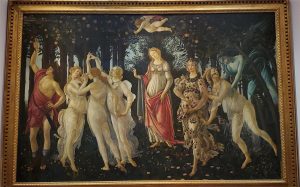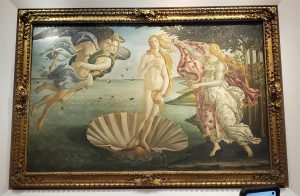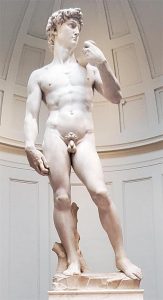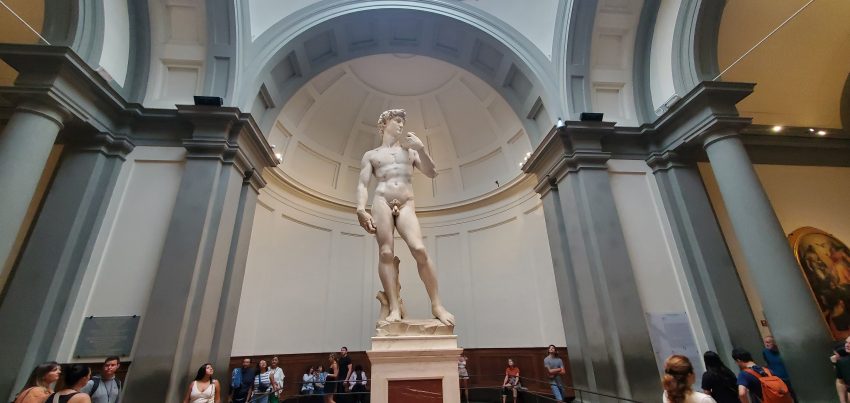Florence is an art lovers dream destination. It is often touted as the birthplace of the Renaissance movement showcasing leading edge architecture, art and sculpture, and a meeting place for some of the best artists of their time – Masaccio, Brunelleschi, Donatello and others.
The Renaissance is said to have started in Italy during the 1300s as a revival in arts, architecture, literature, music and more. Renaissance refers to a “rebirth” of an interest in the classics from ancient times of Greece and Rome and a new discovery of the humanities. Italian Renaissance artists focused more on the ideas of humanism and naturalistic portrayals of the world and people around them. Although it started here this movement found its way throughout numerous countries in Europe.
 Leonardo Da Vinci’s Annunciation c. 1472-1476
Leonardo Da Vinci’s Annunciation c. 1472-1476
There are three main sites that are a must when you visit Florence; the Duomo to see the Baptistery and Brunelleschi’s dome, the Uffizi Gallery to explore work by Giotto, Da Vinci, Botticelli and Rubens and the Accademia to see the amazing David by Michelangelo. Although all three can be fit into one day if you have the time and stamina, they are best spread out so you can really appreciate each one at your leisure. It is essential for all three to make reservations in advance and you can pick your time to enter.

Caravaggio’s Head of Medusa c.1579
The Uffizi Gallery was built in 1560 to house the offices (“uffizi) and general administration for Cosmo Medici. The building was opened to the public in 1769 and became a museum in 1865. It was an essential stop on many Grand Tour itineraries. Our focus was on late medieval and early Renaissance art. The works represented were predominately religious in nature or paintings and sculptures representing Roman mythology and history.


Sondro Botticello – Primavera c, 1470s and Birth of Venus c.1480s
Before you get to the Uffizi Gallery you will find yourself in Piazza Della Signoria, the main square in Florence. Surrounding the square are replicas of different statuary, which is itself is fascinating to see. The copy of David is located directly in front of the entrance to the Town Hall, which is still in use as offices today. The interior courtyard is free to explore but you will need a ticket for the museum.
 The Accademia, founded in 1784 by Pietro Leopoldo, Grand Duke of Tuscany, also features works from the same time period, but its shining star is undoubtedly the original Michelangelo’s David. Featured at the end of the main hall under the dome, it is one of the most recognized statues in the world, and much bigger than you would think, 17 feet in fact! There is plenty of room to explore the sculpture form all sides and even sit and contemplate for a while. Leading up to it are fascinating unfinished works also by Michelangelo, and the rooms on either side showcase other artists of the region. Smaller in size than the Uffizi, it was crowded on the day we visited, mostly with guide led tours.
The Accademia, founded in 1784 by Pietro Leopoldo, Grand Duke of Tuscany, also features works from the same time period, but its shining star is undoubtedly the original Michelangelo’s David. Featured at the end of the main hall under the dome, it is one of the most recognized statues in the world, and much bigger than you would think, 17 feet in fact! There is plenty of room to explore the sculpture form all sides and even sit and contemplate for a while. Leading up to it are fascinating unfinished works also by Michelangelo, and the rooms on either side showcase other artists of the region. Smaller in size than the Uffizi, it was crowded on the day we visited, mostly with guide led tours.
Florence is full of churches featuring original art of the Renaissance era and numerous other small museums and galleries, too many to mention here, but all worth a visit if you have the time. Do so and you will discover why the Italian Renaissance is one of the most renowned and popular eras in art history.
Michelangelo’s David c.1501-1504
